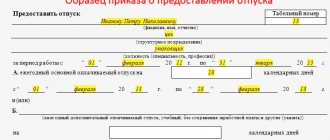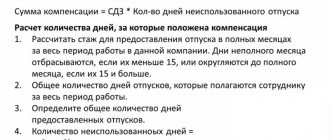Home / Labor Law / Vacation / Administrative
Back
Published: 06/17/2016
Reading time: 8 min
0
3673
A special type of leave, which is distinguished in the labor legislation of the Russian Federation, is administrative, the better known name of which is leave at one’s own expense.
Its peculiarity is that during the rest period the employee retains his job, but wages are not paid.
Thus, it acts as a kind of social support measure for workers who, due to certain circumstances, cannot appear at work. However, in some cases, the employer may also be the initiator of free leave. It is worth considering how legal such actions are and what are the conditions for obtaining leave.
- Legality of the employer's actions
- Grounds and reasons for sending an employee on administrative leave
- Maximum vacation period and amount of payments
- Employer's liability
How is downtime paid?
Downtime can be called a vacation at a stretch. It all depends on the situation due to which the employer suspended work.
Let us remind you that downtime due to the fault of the employee himself is not paid.
If the reason for the unscheduled “rest” of employees was the actions or inaction of the employer, then he is obliged to pay the employees at least 2/3 of their average earnings.
If neither the employees nor the employer are to blame for the unscheduled suspension of work, then employees have the right to claim payment in the amount of 2/3 of their salary or tariff.
We also note that the period of non-working days according to Presidential Decrees in 2021 in most cases was not subject to registration as idle time. First of all, for the reason that workers sent into self-isolation should have received a payment in the amount of 100% of their earnings for these days.
Some employers tried to send their workers on leave without pay. Many were forced to write statements at their own expense. This is illegal, and the employee had the right to complain to the labor inspectorate, the prosecutor's office and go to court.
Forced downtime due to coronavirus: how to register?
Many Russian companies, especially those working in the fields of tourism, holding public events, etc., are now forced to introduce temporary downtime due to the risks of the spread of coronavirus infection, that is, independent of the parties to the labor relationship. The reason for the suspension of production may also be interruptions in the supply of various components from China.
The risks of suspension cannot be excluded in cases where the functioning of the company is impossible due to illness of employees or when they are in quarantine due to the threat of coronavirus - in this case, employees are required to receive paid sick leave.
If a person is not sick or his work in quarantine cannot be organized remotely, the company can transfer the employee to idle mode.
Let us note that the employer has the right to oblige employees to be at work during downtime, since downtime is not a type of rest time (Article 107 of the Labor Code of the Russian Federation). But given the risks of spreading the virus, this is an unlikely scenario.
To register forced downtime, the management of the employing company must:
1. Issue an order (most often it is called an order “On the duration of downtime and its payment”).
The document must reflect:
- who is affected by the downtime regime (this can be either the entire enterprise or individual employees);
- reasons for downtime;
- start and end times of the downtime period;
- the amount of payment to employees during downtime;
- whether workers should be on the territory of the enterprise during downtime or not.
Those employees to whom it applies should familiarize themselves with the order.
2. Within three working days from the date of introduction of downtime, send a notification about it to the territorial division of the Labor Inspectorate (clause 2 of Article 25 of the Employment Law of April 19, 1991 No. 1032-1).
The notification states:
- reason for downtime;
- details of the downtime order;
- downtime;
- the number of employees to whom the order is extended.
During the entire period of downtime, a time sheet is kept. In it, days of downtime, which are not the fault of the employer or employee, are reflected for each employee using the code “NP” or “32”. The spread of coronavirus is an emergency situation, obviously not due to the fault of any of the parties to the employment relationship.
Payment for “forced leave”—downtime for which neither the employer nor the employee is to blame—is at least 2/3 of the employee’s salary or tariff rate, calculated in proportion to the downtime (Article 157 of the Labor Code of the Russian Federation).
Note that if the downtime is due to purely internal economic reasons, that is, when external factors did not play a significant role, it can be recognized as downtime due to the fault of the employer (]]>Appeal ruling of the Vladimir Regional Court dated October 31, 2013 No. 33-3566/2013] ]>). Such downtime is paid in the amount of 2/3 of a person’s average earnings, which may include not only salary, but also bonuses, allowances, etc.
Suspension from work
A forced period of non-working time will also include removal from work. You can be suspended from work for appearing at work in a state of intoxication if the employee has not passed a medical examination or refused to undergo safety training. All these are special cases of suspension from work.
In most cases (though not always), this is the employee’s fault, so such “rest days” are not paid.









